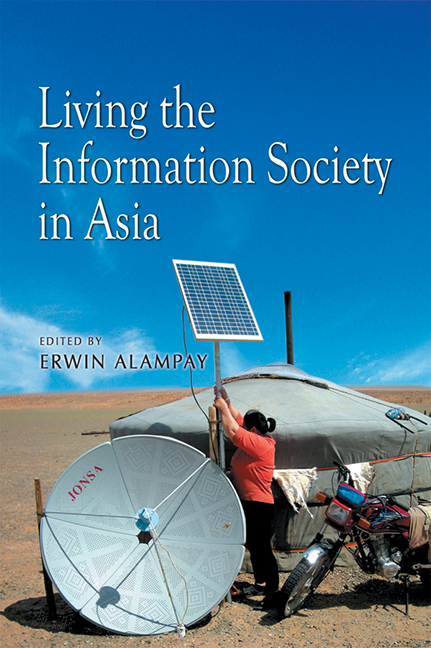Book contents
- Frontmatter
- Contents
- Foreword
- Preface
- List of Abbreviations
- Contributors
- Introduction: Perspectives of ICT Research in Asia
- 1 What Would Durkheim Have Thought? Living in (and with) the Information Society
- 2 What Is a Mobile Phone Relationship?
- 3 Technologies of Transformation: The End of the Social or the Birth of the Cyber Network?
- 4 Becoming Mobile in Contemporary Urban China: How Increasing ICT Usage Is Reformulating the Spatial Dimension of Sociability
- 5 Mobile Religiosity in Indonesia: Mobilized Islam, Islamized Mobility and the Potential of Islamic Techno Nationalism
- 6 Moral Panics and Mobile Phones: The Cultural Politics of New Media Modernity in India
- 7 Stories from e-Bario
- 8 Life and Death in the Chinese Informational City: The Challenges of Working-Class ICTs and the Information Have-less
- 9 Institutional Responses to GIS Adoption for RPTA in Local Governments
- 10 Customer Acquisition among Small and Informal Businesses in Urban India: Comparing Face-to-Face and Mediated Channels
- 11 The View from the Other Side: The Impact of Business Process Outsourcing on the Well-being and Identity of Filipino Call Centre Workers
- 12 Empowering Thai Homeworkers through ICTs
- Index
5 - Mobile Religiosity in Indonesia: Mobilized Islam, Islamized Mobility and the Potential of Islamic Techno Nationalism
Published online by Cambridge University Press: 21 October 2015
- Frontmatter
- Contents
- Foreword
- Preface
- List of Abbreviations
- Contributors
- Introduction: Perspectives of ICT Research in Asia
- 1 What Would Durkheim Have Thought? Living in (and with) the Information Society
- 2 What Is a Mobile Phone Relationship?
- 3 Technologies of Transformation: The End of the Social or the Birth of the Cyber Network?
- 4 Becoming Mobile in Contemporary Urban China: How Increasing ICT Usage Is Reformulating the Spatial Dimension of Sociability
- 5 Mobile Religiosity in Indonesia: Mobilized Islam, Islamized Mobility and the Potential of Islamic Techno Nationalism
- 6 Moral Panics and Mobile Phones: The Cultural Politics of New Media Modernity in India
- 7 Stories from e-Bario
- 8 Life and Death in the Chinese Informational City: The Challenges of Working-Class ICTs and the Information Have-less
- 9 Institutional Responses to GIS Adoption for RPTA in Local Governments
- 10 Customer Acquisition among Small and Informal Businesses in Urban India: Comparing Face-to-Face and Mediated Channels
- 11 The View from the Other Side: The Impact of Business Process Outsourcing on the Well-being and Identity of Filipino Call Centre Workers
- 12 Empowering Thai Homeworkers through ICTs
- Index
Summary
INTRODUCTION: MOBILE RELIGIOSITIES
Modernity, while occurring at a global scale, is multiple in character. It is often lacking the central master-narratives formerly associated with the term modernity. In this contribution, I consider one reading of modernity by focusing on the ways young Southeast Asian Muslims “make themselves modern” in creatively adapting and appropriating mobile communication tools and practices in their everyday lives.
Indonesia, the country referred to in this study, is not only a country that recently has begun to engage with its own mobile modernities, but being home to the largest Muslim population within a single nation, such a mobile modernity increasingly has come to be defined in Islamic terms. The ways mobile technology, and in its aftermath ideas on modernity, is domesticated and deliberated within religious circles has been little studied to date, although recently Katz (2006) has given a brief survey of it. Earlier, Rheingold (1999) touched upon the topic when explaining the Amish's somewhat ambiguous attitude towards new technology and their constant negotiation of its use, including what he calls “their secret affair with the cell phone”. Occasional mention has been made of novel “mobile rituals” such as the SMS Puja service (The Tribune, 5 September 2003), whereby an operator forwards a SMS prayer to Mumbai temples where it may be recited for its senders. Popular media have similarly signalled new forms of public devotion finding its expression in, for example, the popularity of mobile icons of Lord Ganesh in Indian society (Das 2003) or the text gospel described by Ellwood-Clayton (2003) for the Philippines. Most of these practices, once successful, will soon be picked up by adherents of other world religions or by commercial companies addressing religious audiences. But those practices or tools, as will be shown below, are not necessarily easily transposable from one belief to the other. This may be due to local peculiarities but also to religious taboos and restrictions.
In this aspect, mobile communication studies have hardly focused on everyday mobile practices in Muslim societies, let alone the Muslim societies of Southeast Asia. Largely influenced by the political climate, external observers have often been quick to associate mobile religiosity in a Muslim context with extreme practices ranging from SMS divorces by Malaysian Muslims or cell phones being used as detonators by Thai Muslim separatists.
- Type
- Chapter
- Information
- Living the Information Society in Asia , pp. 73 - 92Publisher: ISEAS–Yusof Ishak InstitutePrint publication year: 2009



